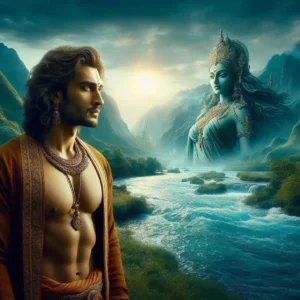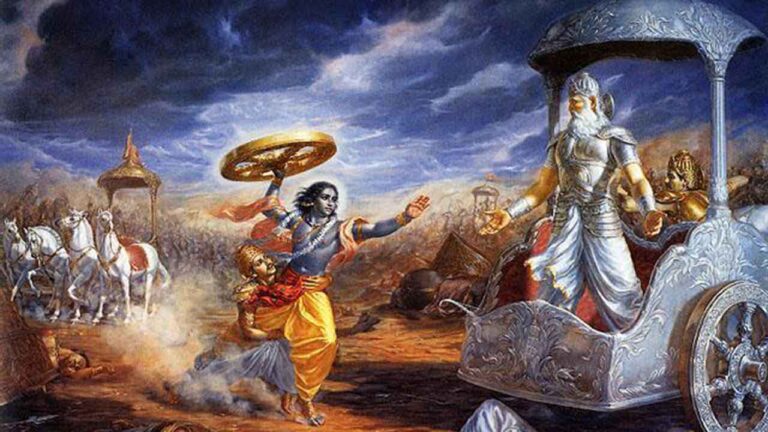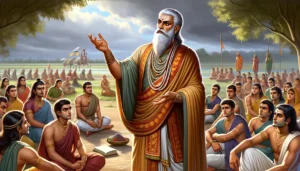Meaning of Mahabharata word
Mahabharata” in Sanskrit translates to” The Great Epic of the Bharata Dynasty.” The term” Mahabharata” itself is an emulsion of two words” Maha”( महा), meaning” great,” and” Bharata”( भारत), about the dynasty of the Bharata or the story associated with the descendants of Bharata, a fabulous king in ancient Indian history. This grand narrates the story of the conflict between the Pandavas and the Kauravas, two branches of the Bharata family, climaxing in the battle of Kurukshetra. It’s a foundational textbook in Indian culture, encompassing colorful aspects of life, duty( dharma), and righteousness
“In a big story about good and bad fights, Mahabharat teaches what’s wrong and what’s right.”
The Mahabharata, an ancient Indian epic, stands as a cornerstone of Indian mythology and culture. Spanning an intricate tapestry of love, betrayal, righteousness, and divine intervention, its genesis lies in the culmination of intricate events, spanning generations. Its narrative is not merely a tale of heroes and villains but a reflection of the complexities of human nature and the eternal struggle between dharma (righteousness) and adharma (unrighteousness). Let us embark on a journey through time to explore the origins of this timeless epic.
Unveiling the Mahabharata’s Origins
The seeds of the Mahabharata were sown long before its actual inception, with the lineage of the Kuru dynasty. The story traces back to King Bharata, after whom India is named. His descendants ruled the kingdom of Hastinapura, located in present-day Uttar Pradesh, India. The Kuru dynasty thrived under the reign of many illustrious kings until it reached its pivotal point with King Shantanu.

Shantanu, the scion of the Kuru dynasty, encountered the celestial river goddess Ganga (Ganges) and fell deeply in love with her. They married, and she bore him several sons. However, due to a pact with her, Ganga drowned each child at birth until the eighth son, Devavrata, later known as Bhishma. Bhishma, owing to his oath of celibacy, remained unmarried, thus ensuring the continuation of the Kuru dynasty.
The story takes a dramatic turn with the ascension of Satyavati, a fisherman’s daughter, to the queen of Hastinapura through her marriage to Shantanu. Satyavati bore two sons to Shantanu, Chitrangada and Vichitravirya. However, both of them died prematurely, leaving no heir to the throne.
Satyavati, desperate to continue the lineage, sought the help of the sage Vyasa, son of Satyavati and the sage Parashara, to father children upon her daughters-in-law.
Satyavati then called upon her son Vyasa to fulfill the duty of fathering heirs for the queens,Vyasa impregnated Ambika and Ambalika, the widows of Vichitravirya through the ancient practice of Niyoga. Ambika, unable to bear the sight of Vyasa during the union, closed her eyes during the union, resulting in her son Dhritarashtra being born blind. Ambalika, on the other hand, turned pale with fear, resulting in her son Pandu being born with a pale complexion.
Rise of Pandu to Power and Matrimony
The birth of Dhritarashtra and Pandu marked the beginning of a new chapter in the saga of the Kuru dynasty. Dhritarashtra, being blind, was deemed unfit to rule and thus, Pandu was crowned the king of Hastinapura. Under Bhishma’s guidance, Pandu mastered archery, politics, governance, and spiritual knowledge. Distinguished as a formidable archer and a Maharathi (a great charioteer-warrior), he ascended to the throne of the Kuru Kingdom. His reign began as he was anointed king, and he was wed to priness Kunti.
However, due to a curse, Pandu was unable to bear children and thus, his wife Kunti sought the boon of bearing children from the gods. With the blessings of various deities, Kunti bore Yudhishthira, Bhima, and Arjuna, known as the Pandavas.
Meanwhile, Dhritarashtra married Gandhari, who, out of devotion, blindfolded herself for life. Gandhari gave birth to a hundred sons, known as the Kauravas, the eldest of whom was Duryodhana. The rivalry between the Pandavas and the Kauravas, fueled by jealousy, ambition, and conflicting ideologies, forms the crux of the Mahabharata.
The narrative of the Mahabharata delves deep into the complexities of human relationships and the consequences of one’s actions. It portrays the interplay of righteousness and moral dilemmas faced by the characters. Throughout the epic, Krishna, an incarnation of Lord Vishnu, serves as a guiding force to the Pandavas, offering counsel and support in their quest for justice.
The Mahabharata culminates in the great war of Kurukshetra, where the Pandavas and the Kauravas face each other on the battlefield. The war becomes a metaphorical battle between dharma and adharma, with each side supported by gods, celestial weapons, and divine intervention.

The war resulted in the annihilation of numerous kings and warriors, including Bhishma, Drona, Karna, and eventually, Duryodhana. In the end, the Pandavas emerge victorious but at a great cost, having lost many loved ones in the process.
The Mahabharata does not conclude with the end of the war but continues with the coronation of Yudhishthira as the king of Hastinapura. Despite emerging victorious, Yudhishthira is filled with remorse and guilt over the loss of lives and the destruction caused by the war. His journey towards redemption and atonement forms the final chapters of the epic.
In conclusion, the Mahabharata stands as a timeless testament to the human condition, encompassing themes of love, duty, sacrifice, and the eternal battle between good and evil. Its origins lie in the intricate web of familial relationships, divine interventions, and moral dilemmas faced by its characters. Through its rich narrative and profound teachings, the Mahabharata continues to resonate with audiences across the world, serving as a guiding light in navigating the complexities of life.
What if kauravas had won mahabharata ?
If the Kauravas had won the big war in the Mahabharata, things in India’s culture, religion, and thinking would have been very different. Instead of stories about good beating evil, we might have had stories that show how tricky and tough it can be to hold onto power. This change would have made people think differently about right and wrong, and what it means to do your duty. It could have also changed how people see the advice given by Lord Krishna in the Bhagavad Gita, making it less important. Art, music, and stories inspired by the Mahabharata would have been different too, maybe focusing more on the challenges of ruling and less on following the path of goodness. In short, if the Kauravas had won, the lessons people take from the Mahabharata about how to live a good life and lead others might have been very different, affecting everything from personal beliefs to the kind of stories told for generations
Who was the biggest warrior in Mahabharata?
In the epic Mahabharata, numerous warriors stood out for their bravery, skill, and strength, making it challenging to single out the biggest warrior. Arjuna was celebrated for his archery and was crucial to the Pandavas’ victory. Bhishma was admired for his unwavering commitment to duty and legendary prowess in battle. Karna was known for his generosity and formidable combat skills, earning him a reputation as a peerless warrior. Dronacharya, the royal guru, was revered for his mastery of military arts and strategic insight. However, surpassing them all in terms of influence and divine power was Lord Krishna. Though not a warrior in the traditional sense, Krishna’s strategic guidance, wisdom, and divine interventions were pivotal to the Pandavas’ success, making him the most powerful and significant figure associated with the epic. His role as a divine strategist and the embodiment of supreme divinity ultimately positions him as the biggest warrior in the Mahabharata, in terms of overall impact and divine prowess



[…] Also read: The Epic Genesis: How the Mahabharata Unfolded Through Time […]